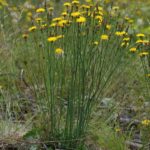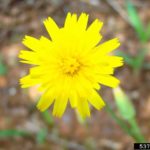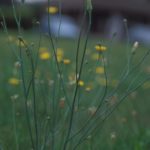Gallery:
- Hairy cat’s ear
- Hairy cat’s ear flower head
- Hairy cat’s ear flower head
- Hairy cat’s ear rosette
- Hairy cat’s ear
- Hairy cat’s ear leaf
Common names:
Hairy cat’s ear, common cat’s ear, false dandelion, frogbit
Scientific Name:
Hypochaeris radicata
Description:
Hairy cat’s ear is a perennial plant in the Asteraceae (sunflower) family, and it is one of the most common weeds worldwide. It grows from a fibrous root system, with thick roots that are similar to a taproot. The stems have a milky juice when broken. Flowers are yellow and dandelion-like, with many green bracts under the flower head. The leaves grow in a basal rosette, are hairy, with wavy or lobed margins, and can be up to a foot long. It produces many seeds that are dispersed by the wind.
Life cycle:
Height of mature plants
6 inches – 2 feet tall
Flower color:
yellow
Bloom time:
spring – autumn
Look-a-likes:
Hairy cat’s ear looks very similar to several other yellow-flowering plants in the Aster family, particularly smooth catsear (H. glabra), smooth hawksbeard (Crepis capillaris), fall dandelion (Leontodon autumnalis), and true dandelion (Taraxacum officinale). However, only hairy cat’s ear has the combination of rounded leaf lobes, hairy leaves, rough leaf surface, and leafless flower stalks, and these features can be used to distinguish it from other species.
Habitat:
Hairy cat’s ear can grow in both natural habitats and disturbed areas. It can tolerate a wide range of soil types, pH, and moisture. It can be found in pastures, orchards, vineyards, roadsides, lawns and gardens, parks, waste areas, and forest edges and clearings.
Impacts:
Hairy cat’s ear will invade freshly disturbed areas, and can crowd out both native species and forage plants. It can also infest seed crops, and is a nuisance in lawns.
Noxious Weed Listing:
- WeedWise: maintenance
- State of Oregon: not listed
- State of Washington: Class C
- Four County CWMA: Class C
- Columbia Gorge CWMA: Class C
Origin:
North Africa, West Asia, and Europe
Links:
Washington Noxious Weed Profile
UC Davis Weed Report
CABI Invasive Species Compendium






